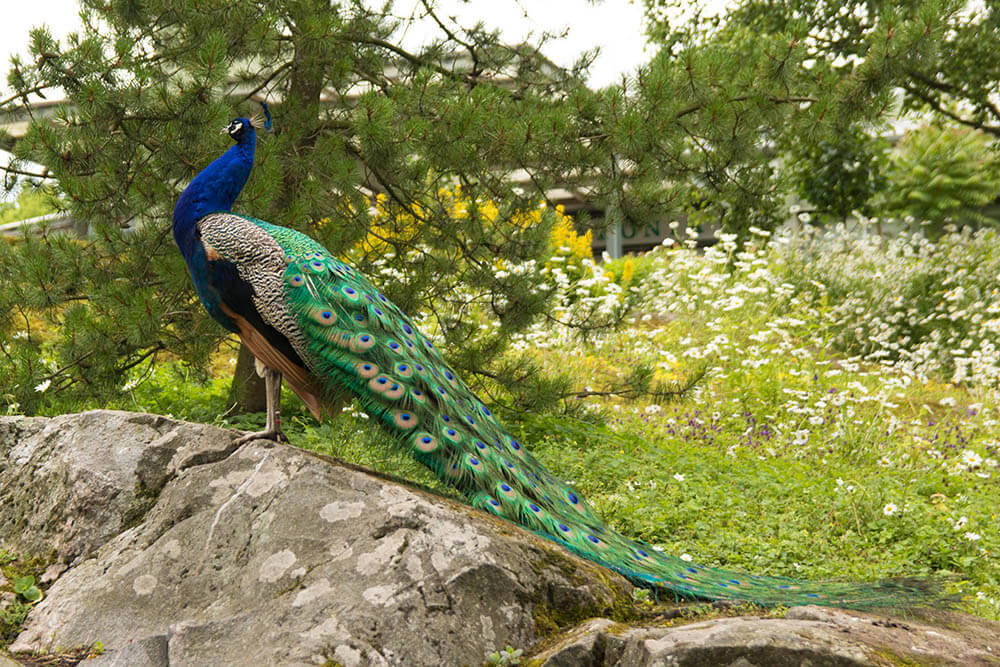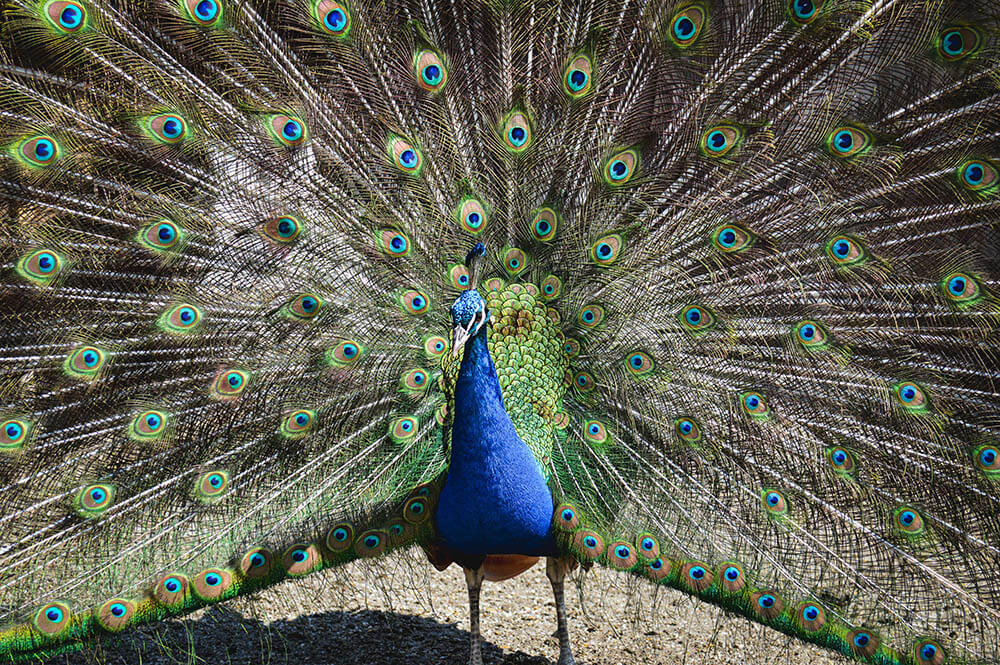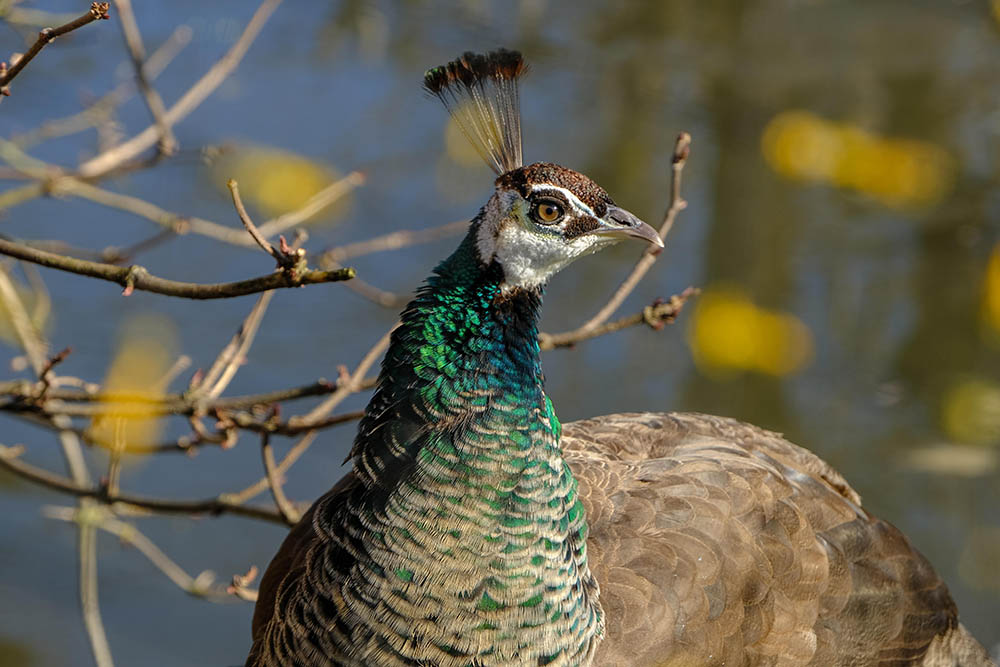Anywhere in the world where there are zoos, there’s a good chance you’ll see a peacock. After all, as some of the most eye-catching birds in the animal kingdom, peacocks are certified crowd pleasers that consistently draw countless people to their artificial habitats.
This doesn’t mean peacocks are native to every part of the planet, however; these animals originate from different regions where some of them continue to thrive. Humans simply took them from these places and brought them to zoos and sanctuaries all over the globe.
In today’s article, we’ll discuss where we can naturally find these amazing animals, so read on to learn more about where peacocks live!
Note: while these birds are popularly known as “peacocks,” the proper, gender-neutral term for the species is “peafowl.” Peacocks are male peafowl, while peahens are female peafowl.

What Is a Peafowl?
A peafowl is a bird known for its beautiful, colorful plumage and unique mating ritual that involves the male spreading his long tail feathers in a wide fan. Only males spread their tail feathers, also known as a “train,” this way. Females in the group examine these displays; if a male’s display impresses a female, she chooses him as her mate.
What many people don’t know is that there are actually three peafowl species, each coming from a different region of the world. Which brings us to…
The 3 Peafowl Species and Where They Come From
The three peafowl species are the blue peafowl (Pavo cristatus), which is found mostly in the Indian subcontinent; the green peafowl (Pavo muticus), which is native to Southeast Asia’s tropical forests; and the Congo peafowl (Afropavo congensis), which makes its home in Central Africa’s Congo Basin.
Blue Peafowl
The blue peafowl is also known as the Indian peafowl or common peafowl. It originally hales from India and Sri Lanka, but calls Bangladesh, Nepal, and Bhutan home, as well.
In the Indian subcontinent, these birds inhabit dry deciduous forests and moist forests. They’re found primarily under an elevation of 5,900 feet (1,800 meters), though they’ve also been observed living in areas around 6,600 feet (2,000 meters).
In regards to their conservation status, blue peafowl are doing well in their natural habitats. This is in part thanks to the Indian government, which illegalized the hunting, killing, and consumption of this species upon declaring it the country’s national bird in 1963. In addition, religious practices help ensure blue peafowl stay safe.
Because they’re so beloved in the Indian subcontinent, these creatures can easily adapt to places outside their natural habitat, such as cultivated and civilized areas where there’s plenty of water. In fact, they’ve taken to foraging for scraps in villages, towns, and even cities.
Humans also took blue peafowl from the Indian subcontinent and introduced the animal to many other regions, such as:
- Argentina
- Australia
- Brazil
- Colombia
- Costa Rica
- Croatia
- Guyana
- Honduras
- Indonesia
- Lokrum
- Madagascar
- Mauritius
- Mexico
- New Zealand
- Papua New Guinea
- Portugal
- Réunion
- South Africa
- Spain
- Suriname
- United States of America
- Uruguay
Humans also introduced these birds to Saint Helena, Ascension and Tristan da Cunha but have since gone extinct in this territory.
The blue peafowl is the kind of peafowl most commonly seen in zoos and thus the most familiar to us.

Green Peafowl
Also known as the Indonesian peafowl, the green peafowl occupies Southeast Asian forests, specifically those in Myanmar (formerly Burma), Laos, Thailand, Vietnam, Cambodia, Indonesia, and Java. It can also be found in China. It’s now extinct in India, Malaysia, and Bangladesh.
The green peafowl is Myanmar’s national bird. These creatures have spread across a broad array of habitats, including primary, secondary, tropical, subtropical, deciduous, and evergreen forests. They live in swamp forests, coniferous forests, open woodlands, and forest edges. They’ve even been discovered in savannas, grasslands, and scrub; amongst bamboo; and near the edges of farmlands.
In Vietnam, these birds prefer dry deciduous forests close to water sources. They also like staying away from places with lots of people.
Green peafowl prefer elevations between sea level and a minimum of around 6,890 feet (2,100 meters).
Today, their populations are densest near wetlands and undisturbed rivers. The availability of water sources seems to be an important consideration when choosing a place to call home.
Loss of habitat has put the green peafowl’s population into sharp decline, which explains why it has been endangered since 2009. According to the International Union for Conservation of Nature (IUCN) Red List of Threatened Species, an international organization that maintains a comprehensive inventory of biological species’ global conservation status, there are only around 10,000 to 19,999 mature green peafowl in the wild – and these numbers continue to decrease.

Congo Peafowl
Referred to as the mbulu by the Bakongo, the Congo peafowl a.k.a. African peafowl is located in Central Africa, specifically in the Democratic Republic of Congo’s forested interior. While it lives in the primary and secondary forests of Salonga National Park, signs of its existence have also been discovered in Maiko National Park. It can even be located in Egypt.
We only recently discovered this species – in 1936. Today, it is the Democratic Republic of Congo’s national bird.
The Congo peafowl lives in various forest types but has a preference for slopes between watersheds, especially those with shallow soils that support dry forest floors with an understorey – or a lower forest tier consisting of small trees and shrubs beneath the primary covering provided by large trees. This animal also likes litter cover and high canopy.
Congo peafowl prefer elevations up to 3,937 feet (1,200 meters).
While the Congo peafowl isn’t endangered, the IUCN Red List considers it near-threatened. Today, there are only between 2,500 and 9,999 mature individuals in the world. Sadly, their numbers continue to decline.

Fascinating Peafowl Facts
If you’d like to know more about peafowl, keep reading!
Peafowl live long lives
Peafowl are among the longest-lived birds on the planet. In the wild, they can live for 10 to 25 years. If given excellent care, a peafowl in captivity can live 40 to 50 years.
Peafowl are sexually dimorphic
Peacocks don’t look the same as peahens. Peacocks boast vibrant colors as well as eye-catching decorative tail feathers. While peahens are also beautiful, they have subtler colors such as brown and gray.
Only peacocks spread out their marvelous tail feathers in the shape of a fan. They engage in this behavior when want to impress potential mates during the breeding season.
Peafowl are aggressive
Peafowl viciously attack fellow peafowl as well as other creatures including humans! Their sharp beak and talons can cause painful injury and in at least one instance killed a fully grown human being.
Various factors contribute to these birds’ ill temper. For one, they take mating season extremely seriously; any individual who disturbs a peacock’s mating display may be seen as a nuisance deserving of a peck in the groin. Peahens are also highly protective of their offspring, which means they’re ready to punish anyone they deem capable of stealing their eggs or harming their chicks.In addition, these birds are extremely territorial. If you come anywhere near them, they may see you as an invader intending to steal their home from them. And to defend their territory from you, they’ll attack you.
Peafowl can fly
Despite their long, heavy tail feathers, peafowl are capable of flight. Don’t expect them to travel vast distances like other birds do, however; peafowl only fly short distances to accomplish simple objectives like perching on tree branches to escape predators or crossing obstacles such as streams.
Peahens can produce five to nine eggs per year
In general, peahens don’t produce eggs during their first year. Once they reach their second year of life, they start laying a few eggs. It’s only when they’re four, however, that they become capable of laying between five and nine eggs annually.
Peafowl are large birds
All three peafowl species are bigger than most birds.
From the tip of the bill to the end of the tail, the blue peacock measures up to 47 inches long, while the blue peahen can grow a maximum of 38 inches long.
The green peacock can reach a maximum length of 118 inches long. The green peahen can reach up to 43 inches long.
The Congo peacock can grow between 25 and 28 inches long whereas the Congo peahen can reach lengths between 24 and 25 inches, making them five times larger than a domestic cat.
Peafowl are noisy
Peafowl are exceptionally loud birds. They’re particularly deafening in the wild, where they live in large groups and perform various vocalizations to communicate with one another.
Peafowl honk and emit high-pitched sounds resembling a shrill meowing or the crying of a baby. When a peafowl notices a predator entering its territory, it produces a quick squawk to warn its groupmates, which then echo the noise. This makes them good “watchdogs” in rural areas. These birds also squawk whenever they enter their habitat to announce their presence to their family and friends.
Peafowl are noisiest during mating season, during which peacocks scream and honk – sounds that peahens then echo.

Conclusion
Three species of peafowl exist, each of them inhabiting a specific region on the planet. The blue or Indian peafowl occupies the Indian subcontinent and surrounding areas. The green or Indonesian peafowl primarily inhabits the forests between Myanmar and Java. The Congo peafowl lives in the Congo Basin in Central Africa.
We can also now find these special animals all over the world in zoos and animal sanctuaries. So if you’re eager to admire a peafowl in person, consider visiting one near your place!
